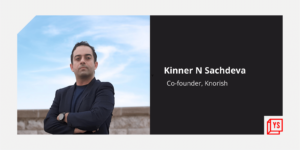Focused on building Trifecta Capital’s Growth Equity Fund, Lavanya Ashok’s love and interest in finance grew strong during her under-graduation programme at Wharton.
“My mother was a finance professional, and while I did have an early influence in the field, I was quite creative growing up. I wanted to be a writer and dancer, at different points. But the calling of the finance and accounting genes was quite strong,” she says.
Growing up in Bengaluru, Lavanya says she had the opportunities to do it all but felt her love for finance grow as a young student at Wharton. As a young graduate, she joined Goldman Sachs at Wall Street as an intern.
Lavanya Ashok
“For a young girl from Bengaluru it was many dreams come true. I worked hard, and focused on the advisory side as an investment banking analyst,” she says.
After working at Goldman Sachs as an intern, Lavanya decided to try her hand at a hedge fund. “This was my first foray into understanding more about technology and its impact on the human life. In 2008, I was also at Stanford. And being at Stanford, you see first-hand how technology changes everything about human lives, makes access better, and transforms everything around you,” Lavanya says.
After her MBA, she went back to Goldman Sachs and worked there for the next 10 years. Here, she managed private equity, and soon she got a call from Trifecta to manage the growth equity fund.
“While I loved my job at Goldman Sachs, I felt this was also the right opportunity to venture into the startup ecosystem. Digital initiatives and Digital India were coming of age. I felt I had the training and experience now to contribute to the journeys of late-stage companies,” she says.
Previously, Lavanya was the MD of Goldman Sachs Principal Investing, and was a senior member of a 12-person team deploying funds from GS’ balance sheet and managing the $8 billion global private equity fund in India.
She has lifecycle investing experience, including investments in Pepperfry, Azure, Cytecare and successful exits in Mahindra & Mahindra, Max India, and TVS Logistics.
Speed dating on Zoom
Speaking of her journey so far in investing in startups and speaking to founders, Lavanya says it is like speed dating on Zoom.
“I think it has been a true testament to technology that you can build trust in a virtual world, where you can get capital as a fund house, and even deploy that into startups,” she says.
She adds that digital adoption has caused a shift in the ecosystem, and “brought the future forward a few years”.
Lavanya adds that she realised that in the late stages, primary and secondary needs of companies and entrepreneurs are being addressed with Trifecta Capital’s growth fund.
She says her experience over the years has numerous examples where entrepreneurs are looking at $20 million to $30 million in funding, but partners at the firm are talking about a $100 million cheque.
The Indian startup ecosystem has various types of capital pool starting from angel investors, seed stage, early funding, and growth capital. Lacunae have largely been seen in stages beyond C, as participants in this category have been sparse.
“We need to bridge that gap to private equity, and can provide that specialised service through late-stage equity funding,” she says.
What does Lavanya look for in an investment pitch? “True understanding of the problem and the excitement to solve it. The ability to garner resources to attack that problem in the best possible way. In the late stage, we look at maturity in team building and self-awareness in the entrepreneur that everything cannot be done by one or few people. Reliance on an army can help reach the goal.”

![You are currently viewing [100 Emerging Women Leaders] How Lavanya Ashok went from working at Goldman Sachs at Wall Street to leading Trifecta Capital’s growth fund](https://blog.digitalsevaa.com/wp-content/uploads/2021/09/100emergingwomen-LavanyaAshok-1631090373683.png)








